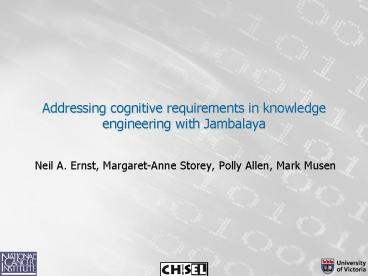Addressing cognitive requirements in knowledge engineering with Jambalaya - PowerPoint PPT Presentation
1 / 10
Title:
Addressing cognitive requirements in knowledge engineering with Jambalaya
Description:
Addressing cognitive requirements in knowledge engineering with Jambalaya. Neil A. Ernst, Margaret-Anne Storey, Polly Allen, Mark Musen. Outline ... – PowerPoint PPT presentation
Number of Views:35
Avg rating:3.0/5.0
Title: Addressing cognitive requirements in knowledge engineering with Jambalaya
1
Addressing cognitive requirements in knowledge
engineering with Jambalaya
- Neil A. Ernst, Margaret-Anne Storey, Polly Allen,
Mark Musen
2
Outline
- introduction the increasing need for cognitive
support in knowledge engineering - identifying tasks requiring cognitive support
- survey
- literature review
- contextual inquiries
- list of tasks
- Jambalaya demonstration
- discussion of non-functional goals for cognitive
support
3
Motivation/Background
- Knowledge engineering is at something of a
crossroads - Semantic Web initiative will see more ontologies
and intelligent apps built, some (most?) by
non-experts - byproduct need for better metaphors for ontology
modeling - not a new problem really, just not looked at much
- better metaphors will need to consider techniques
from information visualization - amplifies human ability to reason and
conceptualize - early tools included this idea
- concept maps, SemNet, KEATS, CODE4
- our work focuses on the modeler, not end-users or
designers
4
Requirements Analysis
- Why? First approach produced a tool, Jambalaya,
which has seen little adoption or evaluation - Approach combination of qualitative techniques
- Literature review
- Tallis et al. 1999 describe problems users
encounter when doing KA tasks - Blythe et al. 2001 describe concerns users have
adding new knowledge to a system - Ng 2000 implemented a tool for browsing a DL
ontology - Clark et al. 2001 non-KE able to enter
knowledge accurately - problem every domain has different challenges
and users. We need to start synthesizing this
work and finding commonalities.
5
Requirements Analysis (2)
- User survey
- Posted a survey to rdf-interest and
protege-discussion about the uses of ontologies
and information visualization - Available at http//shrimpviews.org/jambalaya/user
-survey.htm - Some results
- large number of domains represented
- most ontologies still small, but a significant
number of large (gt1000 frames), - Variety of visualization features requested, and
variety of tools in use
6
Requirements analysis (3)
- Contextual inquiries
- two separate studies of large-scale knowledge
engineering projects at the NCI (cancer research)
and FMA (anatomy modeling) - observed typical users to gain insight into
what tasks are hard to do with current tools - interviewed managers and chief modelers to
determine what their goals were, and where they
saw visualization fitting in. - Some results
- need for custom-built reporting tool to augment
existing system - requests for better navigation and search
facilities - need for better support for collaboration
7
Proposed tasks requiring support
- Using the contextual inquiry, survey, and lit
review, we came up with a list of KE tasks we
think need support in KE tools - facilitate navigation
- overviews
- slot-based browsing
- view query results
- save, annotate, and share views
- support modeling
- graphical editing techniques
- editing navigation
- support reuse
- support verification
- identify incoming relationships
- incremental navigation
- support complex relationships
- in our paper we identify from which research
techniques these were obtained
8
Jambalaya and its feature set
- Based on the requirements/tasks identified, we
evaluated Jambalayas functionality - Tools for manipulating a graph
- Treemap view
- Bookmarks
- Search
- Scripting
- Views on the graph
- Nested
- Tree
- Spring
- Treemap
- Brief demo of sample domain
9
Discussion
- We suggest using non-functional design goals to
examine what level of cognitive support is needed
for e.g. - Customizability to support different domains and
users - Usability problems still getting in the way of
evaluation - Learnability of necessary functions often a
problem - Examine issues centred around presenting the best
metaphor in a particular circumstance - Expressivity being able to reprsenet whats in
the model - Scalability handling meaningful ontologies well
- These goals are necessarily a series of
trade-offs - Evaluation still difficult and under-emphasized
10
Summary of Workshop Discussion
- Themes
- Semantic Web and inserted assertions/inclusions
information sharing - make life easier for users ( cheaper and more
effective) - tools should be relevant to an example/domain not
vice versa - deal with distributed information and 3rd party
sources - query formulation, presentation, and manipulation
- present context of navigation/area of interest
- editing (need to reexamine)
- meaningful products needed
- more end-user focus (esp. tools e.g. Protégé vs
IE (w/o plugins) (address previous topic) - Web services domain needs help (w. execution
models) and popular
http//www.cs.uvic.ca/nernst/vike

